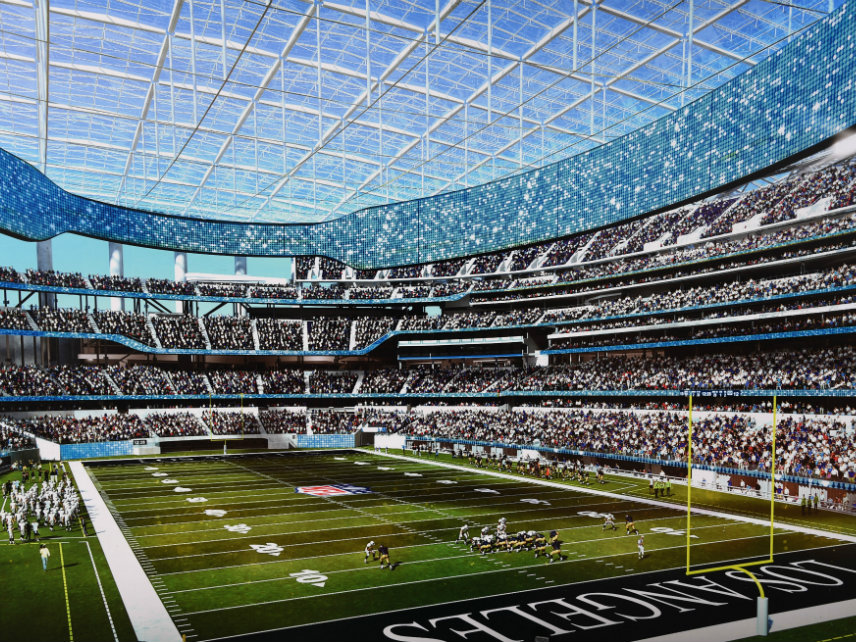Super Bowl-Bound L.A. Rams Are Building the NFL's Most Expensive Stadium, Without Public Money
There's no reason for taxpayers to finance athletic colosseums, and the Rams are providing a model for the next era of new stadiums.

On Sunday evening, the Los Angeles Rams will battle the New England Patriots for National Football League supremacy—and they'll do in inside a brand new stadium in downtown Atlanta that cost Georgia taxpayers about $600 million to build (plus another $24 million for a useless pedestrian bridge nearby).
But back in Los Angeles, the Rams are demonstrating that it's possible to build a sporting cathedral without soaking the public with nine-figures of subsidies, taxpayer-funded bonds, or other corporate handouts.
The Los Angeles Stadium at Hollywood Park figures to be the crown jewel of the NFL when it opens in 2020. It's already slated to host a Super Bowl, probably the first of many, in February 2022—and it will host part of the 2026 World Cup along with the opening and closing ceremonies for the 2028 Summer Olympics. More than 70,000 spectators will fit inside the ultra-modern glass-enclosed stadium surrounded by a complex that will include a concert hall, shopping center, office buildings, condos, a luxury hotel and a 25 acre park. The entire footprint of the site is three times larger than Disneyland, and with estimated construction costs nearing $5 billion, it's likely to be the most expensive stadium in American history.
Most remarkable of all, it's being privately funded.
Stan Kroenke, the Rams' owner, is financing the project with more than $1.6 billion of his own money and a massive loan from the NFL's other owners. He plans to profit off not just ticket sales and concessions at Rams games, but by renting all that office and retail space. He'll have another major tenant as well: the NFL's Los Angeles Chargers. They will pay just $1 per year in rent, but having two teams share the stadium doubles the number of home games on the schedule—and, presumably, the number of fans spending their money at Kroenke's complex (but make your own joke about the Chargers' lack of fans).
Kevin Demoff, the Rams' chief operating officer, tells The Washington Post that the new stadium in Inglewood "will serve as a great model" for the next era of stadium projects. Roger Noll, a Stanford University economist and longtime critic of public spending on stadiums, tells the Post that the Rams new facility is "a really good deal" when compared to any other stadium built in America during the past three decades.
It's not perfect, of course. Inglewood is allowing Kroenke to pocket some of the sales taxes from purchases made in the stadium complex, a kickback that's worth an estimated $180 million to pay for infrastructure and an internal bus transit system. Also, as Noll points out in the Post story, it's possible that other uses for the nearly 300-acre site might have been more productive. But one of the great things about the stadium being privately funded is that those opportunity costs are borne by Kroenke, his fellow investors, and the NFL—instead of by taxpayers.
Contrast that to what's happening right now at the site of last year's Super Bowl: U.S. Bank Stadium in Minneapolis. After hitting taxpayers with a $500 million tab to build a new home for the NFL's Minnesota Vikings, public officials are now shelling out another $3 million to pay for upgrades to a stadium that's only two years old.
Minnesota's stadium is also a nice case study in how incentives change when something is paid for by the public or privately. In Los Angeles, Kroenke is willing to share his new football palace with a crosstown rival because it doesn't make much sense to pay billions for a football stadium that will host no more than 12 games (eight in the regular season, two in the preseason, and a maximum of two in the playoffs) per year. Two teams means twice as many opportunities to earn money.
But in Minnesota, the Vikings owners refused to let a new Major League Soccer franchise rent their stadium—going so far as threatening a lawsuit against the city-run stadium authority that put up the $500 million in public money for U.S. Bank Stadium if a soccer team was allowed to share it. Instead, Minnesota taxpayers ended up chipping in to build a new soccer stadium, too.
Is the L.A. Rams' new stadium a sign that team owners have finally decided to stop fleecing taxpayers? Probably not. After all, Kroenke is just a few years removed from trying to arm-twist St. Louis into spending $477 million to build a new stadium for the Rams—he moved the team to Los Angeles when St. Louis (wisely) refused to do so.
But the new Los Angeles Stadium at Hollywood Park will be a shining example for other cities to use as a counterargument when team owners plead poverty and beg for a handout.



Show Comments (72)